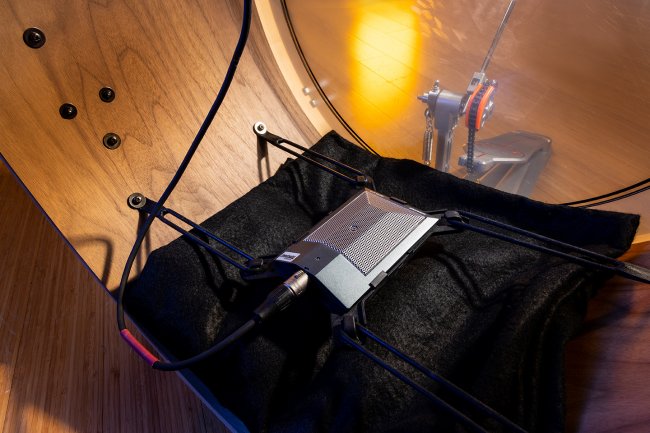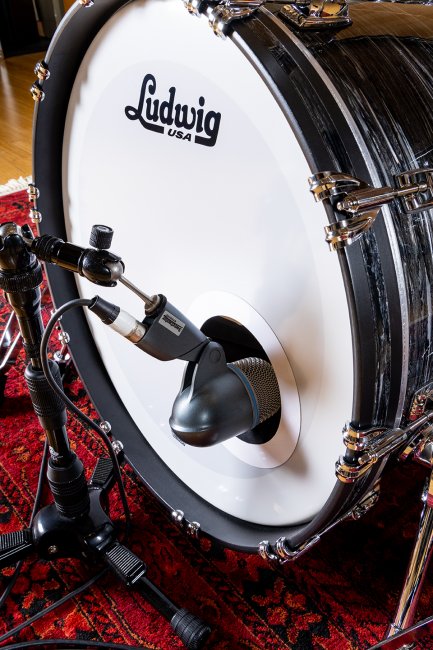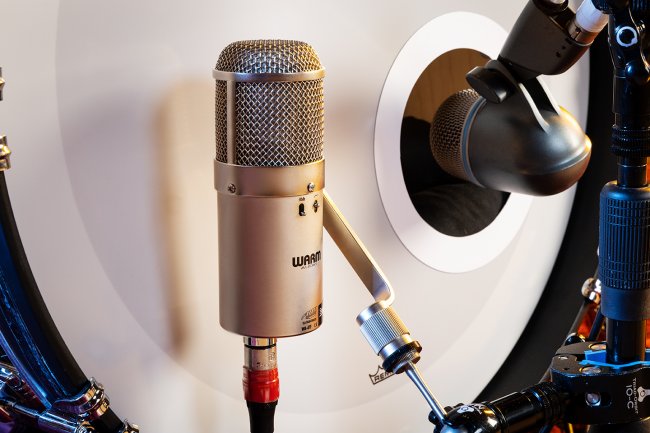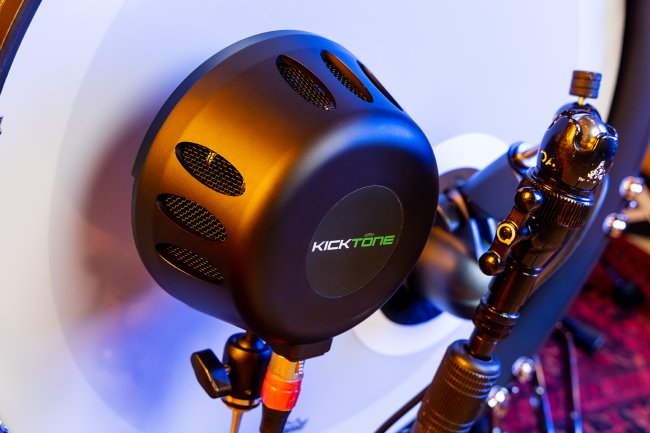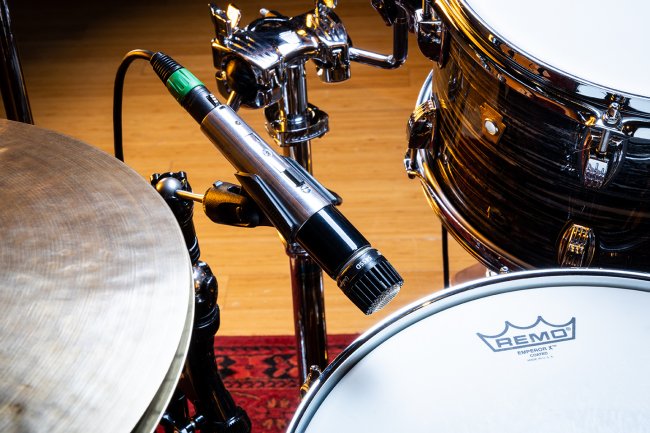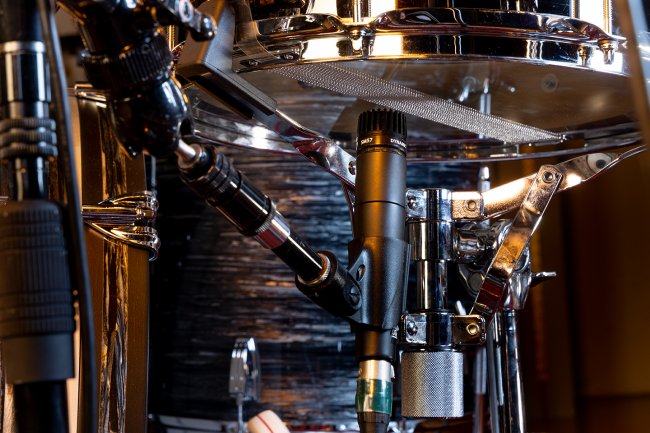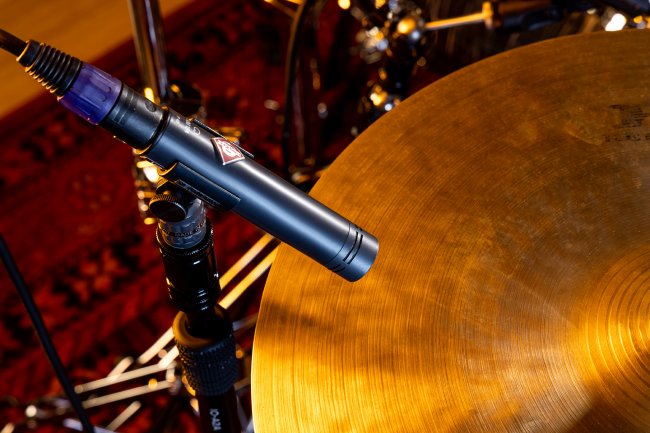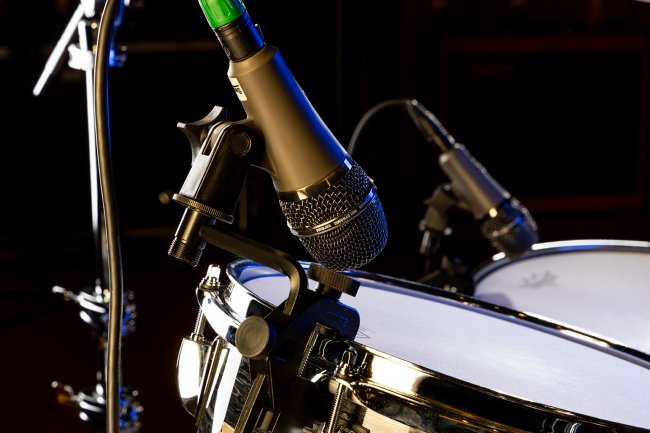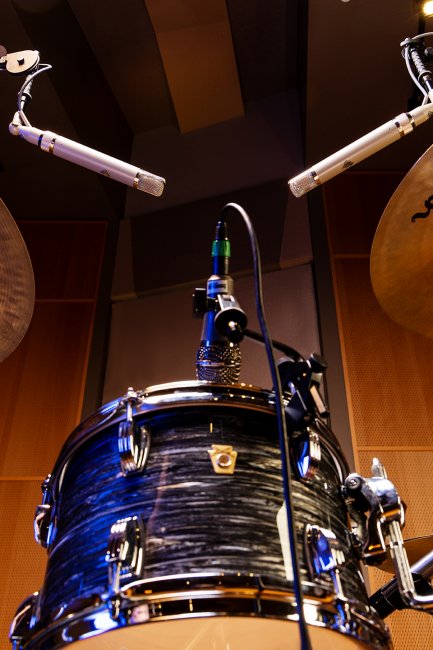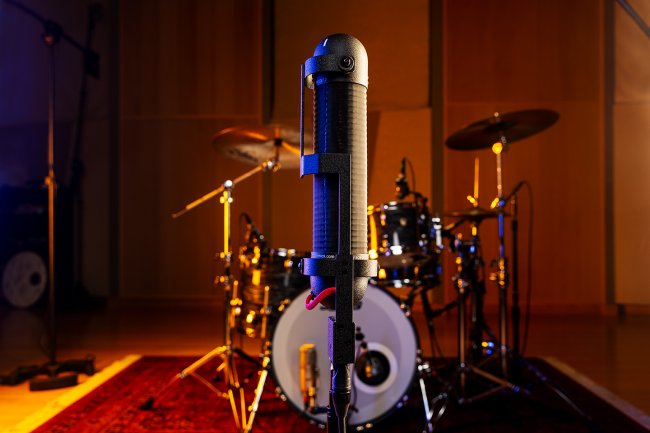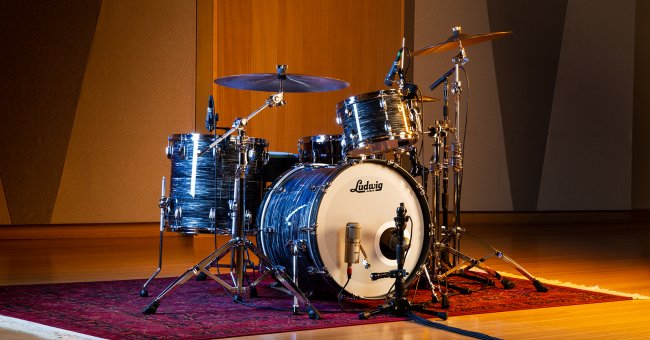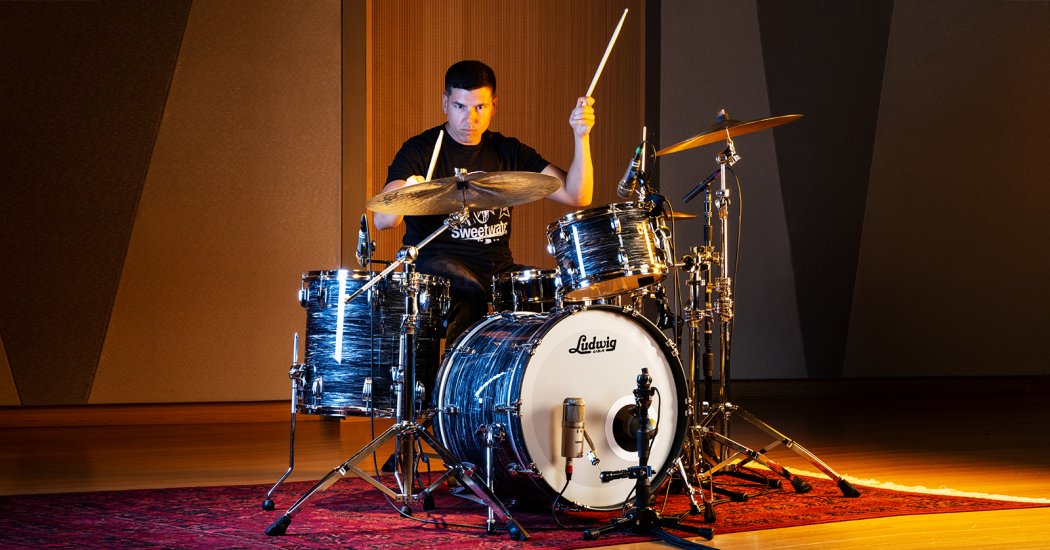
There are lots of ways to mic a drum set. So, let’s walk through how to mic a drum kit — all the way from the kick and snare to the toms, overheads, and rooms, including mic recommendations and suggested placements.
Kick Drum
Kick drums come in lots of sizes — from big and wide (like the Bonham–style 14-inch x 26-inch bass drum found in this 5-piece Ludwig Vistalite Zep shell pack with snare drum) to much smaller. There are lots of mic techniques for getting a great kick drum sound. Below are some miking options you might want to try.
One Mic Outside the Front (Resonant) Head
Putting a mic in front of the outer head is the most common kick drum mic placement, but there are still plenty of variables. Whether you put an Electro-Voice RE20 dynamic broadcast microphone with Variable-D, an AKG D112 MKII cardioid dynamic kick drum microphone, a Shure Beta 52A supercardioid dynamic kick drum microphone, or even a condenser on the outside of the kick, you’ll find lots of variability in the sound depending on where on the head you position it and the distance from the head. For live sound on a kick with no hole in the head, I find that positioning the mic in the lower half of the head about one-third of the drum’s diameter away from the rim will work well. Put the mic between one and three inches from the outer head.
One Boundary Mic Inside the Kick
Placing a boundary mic on a pillow inside the kick is the simplest option if you have a hole in the resonant head. It keeps the bleed from other drums and cymbals to a minimum and will give you lots of impact. Some people like to drop a Shure Beta 91A or a Beyerdynamic TG D71c condenser boundary microphone in the hole, laying it right on the pillow at the bottom of the kick. That gives lots of low end, and it’s a great no-fuss solution because you don’t have to mess with a mic stand. Alternately, for a fixed installation, you can attach the mic to the kick drum by using the Kelly Concepts The Kelly SHU bass drum microphone shockmount kit or the Kelly Concepts Kelly SHU FLATZ system (pictured above), the latter of which is designed for the Shure Beta 91 or 91A.
One Mic Inside the Kick
There are lots of mics that work well inside the kick. In addition to the perennial mic favorites listed above, other popular options include the Audix D6 cardioid, sE Electronics V Kick supercardioid, Electro-Voice ND68 supercardioid, and Telefunken M82 cardioid dynamic kick/bass drum microphones as well as the Sennheiser MD 421-II cardioid dynamic microphone. Using any of these mics on a short boom stand will allow lots of flexibility in positioning. As you move the mic closer to the batter head and closer to the center of the drum, you’ll get lots of attack (click) but not as much low end. Moving off-axis from the center of the drum will yield a more balanced sound (low end to top end), and moving away from the head will change the sound even more. I typically position the mic off-center on the batter drumhead (at about one-third of the drum’s diameter) and about halfway back in the depth of the shell. Others will position the mic right in the hole in the resonant head (as pictured above), which yields a very potent sound with lots of “oomph.”
Two Mics Inside
Laying a boundary mic inside the drum for the low end, combined with another stand-mounted mic for the attack, gives a lot of flexibility when crafting an awesome-sounding kick. Boundary mics, like those mentioned above, resting inside the kick with a mic on a stand positioned near the beater will yield excellent results. Cardioid dynamic mics like the Sennheiser MD 421-II or Shure SM58 will work well for capturing the attack.
One Mic Inside & One Mic Outside
You can get great results by using an inside kick mic combined with a mic outside the kick. Many people use a large-diaphragm condenser microphone, such as the Neumann U 47 FET Collector’s Edition or the more affordable Warm Audio WA-47F FET (pictured above), outside the kick. I love the low end I get from positioning a Royer R-121 studio ribbon microphone in front of the kick centered on the head, just a few inches from the head and angled at 45 degrees. (Note: Royer recommends at least 12 inches.) Mix the two mics together to get a sound as big or as pointy as you like.
Note: If you’re using a ribbon mic on a kick drum, then stay away from the hole because that’s where a huge rush of air is forced out when the drum is played. That rush of air can damage the delicate ribbon.
Note: For the outside mic in front of the kick, you can also use the KickTone multi-purpose dynamic full-range microphone (pictured above) for picking up low frequencies, too.
Snare Drum
Microphone choice has a huge impact on the sound of a snare drum. Popular options for live or recording uses are the Shure SM57, Shure 545SD, and Audix i5 cardioid dynamic instrument mics as well as the handheld Telefunken M80 supercardioid dynamic vocal microphone.
Over
The typical way to mic a snare drum is to put a mic slightly over the snare, and you’re done. While that will definitely work, a greater deal of finesse can and should be applied. My typical starting position is placing the mic about an inch and a half above the head, two inches inside the rim, and aimed down at the center of the head. If I want less low end, then I move the mic higher and farther away from the drum or farther from the center of the head, which diminishes the low end due to diminished proximity effect.
Over/Under
If you want more buzz or more “snare” sound (the wires that run under the bottom head) from the drum, then adding a second mic under the drum is a great idea. Point the under-snare mic at the snare wires from a few inches away. Listen to the under-snare mic combined with the over-snare mic, and reverse the polarity of the under-snare mic from the over-snare mic. If you’re not sure which is correct, then listen as you switch the polarity and use whichever setting yields the most low end.
Hi-hat
Depending on the drummer and the musical style, hi-hats can be so loud that some engineers don’t even bother miking them, but it’s a good idea to put a mic on the hats just in case you need it. When miking the hi-hats, put the mic about two to three inches above the top cymbal and between the bell and the outer cymbal edge. If you get too close to the edge of the cymbals, then you’ll end up with a cuppy sound that accents the opening and closing of the hats. If you put the mic too close to the bell, then you end up with a pinging sound. If you mic hi-hats from the sides, then you’ll get a rush of air every time the hi-hats close together. Experimentation with placement is critical, and each drummer’s hi-hats will sound different (brighter/darker) according to their playing technique, so try different placements and mics depending on how the hats sit in the mix.
Some of my favorite hi-hat mics include the Shure SM81, AKG C451 B, Neumann KM 184 cardioid, and Audio-Technica AT4051b small-diaphragm condenser microphones.
Toms
Like all drum miking, there are lots of options for microphone choice and placement with toms. If you’re in the studio, then you can employ whatever mics (regardless of size) and all the hardware you need. For stage, and especially for video, however, you might need microphones that are less visible. For mic placement when using mic stands, many of the same rules for snare miking apply. Put the mic near the outer rim of the tom head and point it downward.
One big determining factor when it comes to tom mic placement is the presence of the cymbals — both physically and sonically. Some drummers position their cymbals so low over the toms that getting a microphone beneath them is very difficult. In that case, a low-profile, clip-on dynamic mic, like from this Sennheiser e 604 cardioid drum mic 3-pack, may just be the ticket. The Granelli Audio Labs G5790 dynamic instrument microphone, which is a classic SM57 with a right-angle bend in the middle, also works well. One of the studio-standard mics for toms is the Sennheiser MD 421-II cardioid dynamic microphone, which sounds amazing. When it comes to condensers on toms, the low-profile, large-diaphragm Artist Elite Audio-Technica AE3000 sounds really sweet. And if you’re doing a video shoot and need a mic that is nearly invisible to cameras, then the Shure Beta 98AMP/C cardioid condenser gooseneck microphone with XLR preamp is tiny and affordable yet doesn’t compromise on sound at all.
Note: Some engineers think that using hypercardioid mics on toms is preferable for rejecting cymbals from the rear due to the tighter polar pattern hypercardioids provide. But many hypercardioid or supercardioids have a high-frequency lobe (area where it picks up sound) directly behind the mic, and it’s frequently worse in the high-frequency range (5kHz and above). Using hypercardioids on toms might actually accent the cymbals that are directly behind the mic far more than using a standard cardioid dynamic would.
Overheads
There are lots of different approaches for overhead mics. There’s Eddie Kramer’s technique of positioning three Shure KSM44A large-diaphragm condenser microphones to the left, center, and right in a triangle shape over the drums. Glyn Johns also uses three mics (if you include the kick drum mic), positioning the overhead mics equidistant from the snare at roughly 11 o’clock and three o’clock over the drums (from the drummer’s perspective).
The most common overhead miking setup is probably two spaced cardioids above the drums over the left and right sides of the kit (as pictured above). I’ve tried using mic pairs in XY or even in M-S over the drums, but I generally go back to a spaced pair.
Personally, I’ve had the greatest success gathering an overhead perspective of the entire kit instead of just the cymbals. When recording, I start dialing in my drum sound by listening to only the overhead mics and then filling in with the spot mics. I generally use darker, more colored mics than if I was just trying to pick up the cymbals. I’ve used Audio-Technica AT4047/SV cardioid large-diaphragm condenser microphones for about a dozen years, but I’ve also had success with Neumann U 87 Ai and AKG C414 XLII/ST large-diaphragm condenser microphones, DPA 4006A omnidirectional condenser microphones, and Telefunken C12 large-diaphragm tube condenser microphones (as seen above) through the years. And the Audio-Technica AT5045 large-diaphragm condenser microphones sound great on drum overheads and are a new favorite here at Sweetwater.
Room
Capturing the room (the space around the drums) is often critical to getting a good drum sound because it can be the glue that holds all the disparate multi-miked tracks together. A pair of mics that is positioned four feet in front of the kit and about two feet above the floor can give a great overall sonic picture of the totality of the kit. A stereo ribbon mic, such as the AEA R88 MkII or the Royer SF-12, excels at this job. You can also position mics as far away from the drums as possible, depending on the size of the room you’re recording in. A pair of LDCs spaced 90 degrees apart from the drum center works well. Or, if you’re in a smaller room, then you can put dynamic mics in the corners pointing away from the kit or figure-8 mics in the corners with the drum kit sitting in the nulls (90 degrees off-axis) to create a bigger room sound.
Drum Miking for Video
When trying to keep a clean-looking setup for video where the visual is just as important as the sound, there are helpful tools you can use. Utilizing mic clips that attach to the drums, such as the Shure A56D universal microphone drum mount used for the toms in the photo above, can go a long way in cleaning up the look and minimizing mic stands. Also, Triad-Orbit makes ingenious solutions for maximizing mic positions while minimizing clutter, such as its dual mic system microphone stand package for snare drum and its complete kick drum system microphone stand system seen in the photo above.
Sweetwater Has Whatever You Need
If you need microphones or stands for capturing a great drum sound, then Sweetwater has what you need. Or, if you have a challenging situation that calls for expert advice, then we have knowledgeable engineers standing by. Call your Sweetwater Sales Engineer at (800) 222-4700, and they can connect you with all your drum miking needs.


